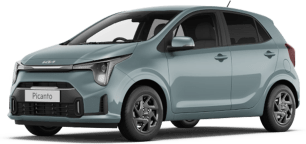Feeling a little old or not, the Picanto has a clever interior which makes the most of its limited dimensions.
There are huge bottle holders in the front doors, a further two with little flip-out sectors which sit below the air-con controls. These holders can be folded away to turn this space into a tray for the storage of large objects. There's even a centre armrest console box, but it's tiny.
On the topic of air-conditioning controls, these are, refreshingly, physical dials, which are increasingly going missing as manufacturers move such functions to touchscreens. The Picanto keeps things manual though, even including a volume and tuning knob for the touchscreen, with physical shortcut buttons adorning the bottom section of the frame.
Physical controls is something Hyundai Group has committed to, and it's not until you use a vehicle without them you realise how essential they can be.
Despite its tiny footprint, there's also plenty of room in the cabin for an adult my size (I'm 182cm tall). I felt as though there was massive airspace between my head and the roof, as the Picanto's seats let you sit nice and low to the ground, and while it's limited in its width, it feels like I had enough room and adjustability for my legs.
Only one area brought me discomfort and it was the elbow-rest in the door. Sounds silly, but while the GT-Line has a little synthetic leather strip here, for some reason it has no padding, so it's seemingly for aesthetic purposes only and is still an uncomfortable place to rest your elbow on longer journeys.
It sounds unlikely, but I fit behind my own driving position in the back seat, with my knees almost up against the back of the front seat. Thankfully, the seat backings are softly-clad so even if you were slightly taller than me it might be ok.
Again, headroom is sufficient, and the seats are reasonably comfortable in the outer two positions. There are no amenities in the back seat. Rear passengers don't get air vents, door pockets, or a drop-down armrest in the centre position. There is only a small pocket on the back of the passenger seat. Can't say it would be the best space for longer journeys, but it fits adults for short city trips.
The boot measures 255 litres. It's small enough it may rule the Picanto out for some family buyers who need to wrestle with a pram or some such. The boot is large enough to fit either the largest CarsGuide luggage case on its own, or the two smaller ones, but absolutely not all three. It may surprise you to learn there is enough room under the floor for a space-saver spare wheel.



























































